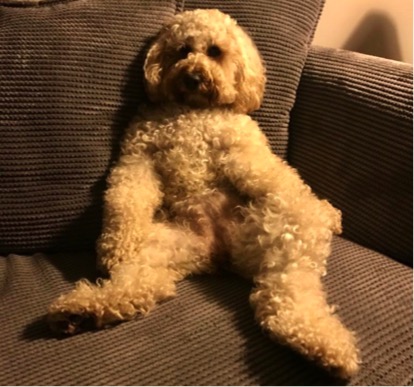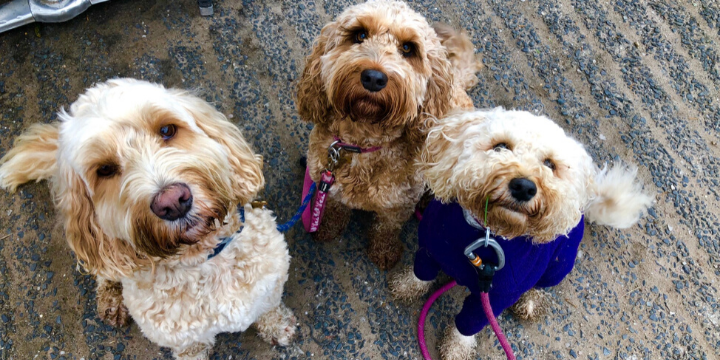A question most people ask when they’ve had their cockapoo puppy for a while is
‘At what age do they calm down?’
And I was no exception.
When you dream of a calm cockapoo
One of the fun aspects of owning a cockapoo – or any high energy dog for that matter – is that they’re balls of adorable, energetic, fluffy fun. However, by the time Freya reached her early teenage years, her energy was boundless; zoomies – or doodle dashing – was an everyday occurrence. Bouncing and leaping gleefully like a gazelle between our three sofas in the sitting room, meant Freya was banished unless we were present! I dreamt of a calm cockapoo; it seemed our only respite was when she slept.
The switch
Well I kid you not, Freya reached two and it was as if a switch that from six months had been on full beam, suddenly engaged its dimmer and turned to a more subdued, but serene light. Challenging teenage behaviour fizzled out, recall was impressive, all the behaviour training she’d been taught as a puppy returned, and at last I had a calm cockapoo.

That’s not to say Freya lost any of her personality; she’s still bonkers at times, especially when playing with her doodle pals, or when her Dad comes through the door, and she still gets highly over excited when greeting friends.
So when does your dog become an adult?
Interestingly, when researching this question, I discovered an article that stated seven human years being equal to one dog year is a myth. It stated that a dog’s age depended on the size and breed. Freya – as a small standard cockapoo – is classed as a medium dog. At two she is actually equal to 24 human years, not the 14 I had been led to believe, so it makes total sense that she should be showing signs of adult maturity at two. Her skeletal mass is now fully formed, she has all her adult teeth, and her permanent coat has finally emerged from her fluffy puppy one.
It was Jessica Orwig, writing in Business Insider, who reported that [abridged]:
“The reason dogs can reach full sexual maturity after only one year is because they age faster during the first two years of their lives than humans do, therefore, calculating your dog’s age relative to yours is a tricky, but possible.”
Naturally, all dogs are individuals; just like humans they mature at different times, but I’m delighted that something clicked in Freya and there was a notable change when she turned two. But there was also a downside.
The downside to your calm cockapoo
With maturity came uncertainty. Puppies dive into any situation completely oblivious of danger; they either learn to take care through behaviour training, or by their mistakes. With the change, Freya suddenly became nervous of people approaching us. Instead of bouncing up and greeting anyone and everyone, her protective instinct kicked in and she began barking at people she didn’t recognise. This was new and at times, highly embarrassing. Freya also began the strange habit of running up to people who had encouraged her so they could say hello; as they moved forward to stroke her, she’d run away!
This behaviour was understandable as Freya became conscious that not everything around her was a positive force. Cautiousness emanates from experience; Freya is highly intelligent and evolution has dictated that it’s her role to warn and protect me from danger.
in when a stranger walks past the window and they run to let us know.
Also as Freya moves into adulthood she has begun to assert her wants and needs. When she wants an apple she quite literally points to them, at bedtime she sits quite firmly in the sitting room, refusing to go willingly onto her bed in the kitchen, even with tempting bedtime biscuits on offer; a sign of separation anxiety we wondered.
I remain determinedly in control of course; we’ve come a long way during the last two years of training to have Freya dictate her needs to us now she is two. That said, we are empathetic to her needs and try to ensure she feels safe and remains as happy as possible.

Freya while Ruth and I have a coffee at Tatton Park
How to raise a calm cockapoo
The temptation to over stimulate your cockapoo is a biggie, even though you have no idea you are doing it.
We’re told with any poodle cross comes intelligence, the spaniel combo means they’re also super energetic. So as caring owners we set about ensuring they have plenty of the mental and physical stimulation we believe they need. It feels logical that the more your dog is exercised, the more exhausted they will become, which in turn means the calmer they will be. But this is not necessarily the case; they can become over stimulated, with adrenalin pumping through their veins for several hours afterwards.

Tips from a Novice
- Once your puppy has reached 12 months, increase the length and difficulty of the walk gradually. If we went for walks of over two hours – the longest to date was seven hours walking steep fells with lots of exciting smells and water splashing – Freya had a rest the following day with leisurely ‘sniff’ walks.
- If, like Freya, your doodle enjoys regular meet ups with other dogs, racing around and getting over excited, it’s a good idea to give them down time. Put them back on the lead for ten minutes or so; this soon calms them down while you gain control.
- The same when they have interaction with another dog while out on a walk. This can raise their adrenalin levels substantially and they leave the play totally hyper. Lead re-attachment can bring this down to ensure you are once more in control.
- Sensory stimulation, such as sirens, gun shots (we live in the country), can be startling and lead to a bolt. I always continually assess what’s happening around us on walks when Freya is off lead and thankfully have avoided this happening so far!
- I leave Freya with open access to the kitchen, dining and sitting room when I leave her alone. She is able to see out of floor length windows, which is a plus as it entertains her; the downside is she can get stressed when she doesn’t like what she sees and begins barking. Regular negative visual stimulation, if not reassured so they get used to it, can be frightening or confusing and work against you raising a calm cockapoo.
- Play is an important part of life for Freya. Cockapoos need the mental stimulation and energy burn while running and playing with other dogs, but you can cause over arousal through exercise in any breed of dog. The notion of exercising a cockapoo to wear it out could go against you and trigger stress related health issues. I was surprised to learn how much damage you can do after reading an article written by a dog trainer [see From the Expert here]. This means I ensure that if Freya has had an exciting play walk for a few hours with other dogs and doodles, she has a calming, relaxed sniff walk the next day.
So raising a calm cockapoo really does take time and patience for the first couple of years, but it will reap its rewards for both of you. Freya is now a lovely, friendly and most of all a calm cockapoo, trained as a therapy dog to work with children who enjoy the simple pleasure of having her around.